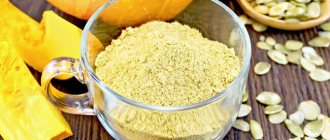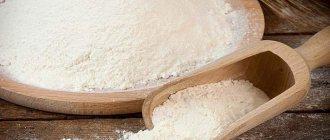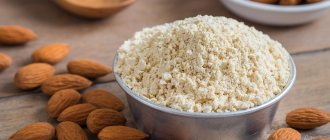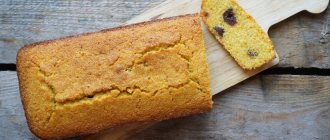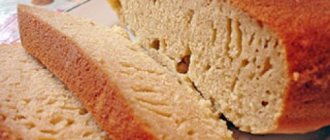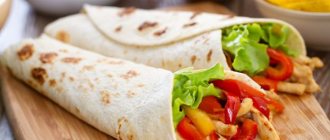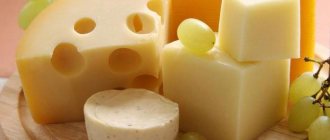Chemical composition of buckwheat flour
Buckwheat flour is the main component of a balanced healthy diet due to the presence of a large amount of vitamins and minerals. The main feature of the product is the complete absence of gluten, which has a beneficial effect on both the general well-being of a person, his health, and his figure.
| Vitamins | Minerals | ||||
| macronutrients | microelements | ||||
| IN 1 | 0.3 mg | Phosphorus | 249 mg | Iron | 5 mg |
| AT 2 | 0.18 mg | Potassium | 130 mg | ||
| E | 0.4 mg | Magnesium | 48 mg | ||
| RR | 6.3 mg | Calcium | 42.1 mg | ||
| Niacin | 3.1 mg | Sodium | 3 mg | ||
It contains natural antioxidants that have a positive effect on human life and can also bring invaluable benefits to the body. With proper preparation and use of the product, you can achieve maximum exposure to beneficial properties and eliminate harm.
Nutritional value and calorie content of buckwheat flour
Buckwheat flour, the properties and benefits of which are explained by the content of biologically active substances important for the human body, is popular among those who want to quickly lose weight. The calorie content of buckwheat flour per 100 grams is only 353 kcal. This indicator is practically no different from ordinary wheat flour, which is in greater demand, but is not capable of bringing such benefits to a person.
| Calorie content (kcal) | Proteins (g) | Fat (g) | Carbohydrates (g) |
| 353 | 13,6 | 1,2 | 71,9 |
The nutritional value and benefits, according to all nutritionists, are undeniable due to the relatively low carbohydrate content, which cannot be said about other types of flour, which are recommended to be replaced with buckwheat flour, which has much more beneficial properties.
Selection and storage
On sale you can find buckwheat flour of light and dark color. Both types have equal nutritional value, but the light one is more popular due to its more aesthetic appearance in baked goods. The product should be stored in a cool, dry place in an airtight container.
Important! The refrigerator is the best place to store buckwheat flour. Such storage will not only extend the shelf life of the flour, but also preserve all its beneficial properties.
If all storage conditions are met, buckwheat flour can be used for up to 7 months, however, to obtain maximum benefits, it is advisable to use it within 3 months.
What are the benefits of buckwheat flour?
The beneficial properties of buckwheat flour for the body include the treatment and prevention of many diseases.
Regular consumption will improve your health and also help:
- increase the level of hemoglobin in the blood;
- stabilize the functioning of blood vessels;
- get rid of excess cholesterol;
- cleanse cells of toxins;
- strengthen the immune system;
- reduce the occurrence of gallstones;
- normalize the metabolic process;
- remove excess fluid, relieve swelling;
- facilitate digestion;
- improve intestinal motility;
- reduce the possibility of subcutaneous fat formation;
- eliminate brittle nails and hair loss;
- eliminate epithelial aging;
- promote normal brain activity;
- relieve nervous tension and general body fatigue.
The product is actively used in many industrial areas due to a number of useful properties. With long-term use, you may notice an improvement in mood and overall health.
The benefits of buckwheat porridge for babies
The baby is unadapted to environmental conditions and is vulnerable, so it is important for him to provide proper nutrition, agree with the doctor on the timing of the start of complementary feeding and study the products offered for this in order to get the maximum benefit from them.
Buckwheat flour is very important for baby food due to its balanced vitamin and mineral composition. It is recommended to introduce it into complementary feeding for infants starting from 6 months, since the healthy grain has a positive effect on the proper formation of bones due to its many beneficial properties.
Advice! You can cook buckwheat flour gruel for an older child by adding sugar, salt and dried fruits, gradually increasing the thickness of the mass.
We recommend reading: What are the benefits of dried fruits, properties and reviews
What type of product can be used for PP: review of useful types
Most weight loss diets require a complete elimination of flour. Such a restriction is not justified, because in addition to wheat flour there are many more varieties. They have a low glycemic index and low calorie content.
It is enough to replace wheat flour to get tasty and healthy baked goods. Here are several types of flour that are suitable for proper nutrition.
Buckwheat
The glycemic index of buckwheat flour is 50, and the calorie content per 100 grams is 353 kcal. Such indicators are considered elevated, but this product has other positive qualities. For example, buckwheat does not contain gluten. This protein is not recommended on a healthy diet:
Wheat is the leader in gluten content. To improve health, it is better to replace it with buckwheat. The color of buckwheat flour is gray, and the dough turns out hard and dense, without the required viscosity. To get the desired consistency, you need to add eggs, oatmeal or flax seeds.
Buckwheat flour is suitable for preparing:
Such baking will not harm your figure.
In order for flour products to benefit the body, you need to avoid frying them in vegetable oil or butter. Pancakes and flatbreads are best baked or cooked in ghee.
Buckwheat flour has another feature - it lowers blood sugar.
Baking is useful for diabetics, heart patients and all those who care about their health. Buckwheat flour contains vitamins and microelements:
Buckwheat flour is a source of vegetable protein, fiber and complex carbohydrates. BJU per 100 grams of product:
For athletes and vegetarians, products made from buckwheat flour help increase the level of protein in the diet and enrich the body with dietary fiber.
Corn
The glycemic index of corn flour is high - 70, the calorie content is slightly lower than buckwheat - 330 kcal per 100 grams. Despite this, oatmeal is considered a healthy food product. Cornmeal is high in fiber and gluten-free , so baking improves digestion and aids in weight loss.
Like corn itself, the flour has a sweetish taste and a pleasant light yellow tint. It is suitable for preparing pp sweets:
Baked goods made from corn flour are not fluffy, but soft and tender. To make the dough pliable, you need to add eggs or cottage cheese. Chia and flax seeds and vegetable oil have good stickiness.
Corn flour contains many useful substances:
For those who think that eating healthy is expensive, corn oatmeal breaks the mold. Its cost is no higher than the price of wheat flour, and BZHU per 100 grams is much more pleasant:
Corn flour:
Rice
Rice flour has one of the highest glycemic index values - 95 units. The product is not recommended for people suffering from diabetes and obesity. Calorie content per 100 grams – 366 kcal.
Rice flour is useful for proper nutrition: baking cleanses the body of toxins and relieves swelling. Compared to premium wheat flour, rice flour contains half as much fat. It is also gluten free.
Whole grain rice flour has a nutty flavor with a slight sweetness. It is suitable for making baguettes, cookies, pancakes. White rice flour does not have a strong taste; it can be used to make bread and flatbreads. To make the dough soft, you need to add more water and mix with other types of flour.
The disadvantages of rice flour include a high glycemic index and a low amount of fiber.
But every Eastern diet includes rice-based products. It promotes weight loss and cleansing of the body. It contains many useful substances:
The high content of microelements and vitamins makes rice flour one of the healthiest foods in a healthy diet.
Oatmeal
Oatmeal is suitable for maintaining a good mood during a diet. Transitioning to a healthy diet can often be stressful, especially for overweight people. Oats contain substances that help produce serotonin, the hormone of joy. It stops the craving for overeating and sweets.
Oatmeal contains gluten, but it is less than wheat. Therefore, oatmeal is recommended for baking on a healthy diet. The dough turns out tender and airy. You can make your own oatmeal. You need to grind the oats in a blender to a powder state.
Baking made from oatmeal can be eaten in limited quantities - it contains a lot of fat. The dishes make digestion more difficult in the evening, so they are not suitable for a late dinner.
Made from oatmeal:
Cookies are the most famous sweet on pp-food.
The glycemic index is within the average range of 45 units.
Among all the raw materials used to produce oatmeal, oats have the lowest level of carbohydrates - 58%. Useful substances in flour:
Oatmeal is the main ingredient for preparing an unusual dish - oatmeal pancake. This is a balanced breakfast made from a mixture of eggs and oatmeal.
BZHU oat flour per 100 grams:
Rye
Rye flour contains a useful component - lysine. He helps everyone who wants to change their figure for the better and plays sports. Heavy exercise can break down muscles, but baking with rye flour will help strengthen body tissue. Lysine increases energy expenditure and helps to lose excess weight without stressing the body.
How to use buckwheat flour for medicinal purposes
Traditional medicine welcomes the prevention and treatment of various diseases with buckwheat flour. Our ancestors also used this product for their own purposes, and traditional healers added it to potions and healing mixtures.
Buckwheat flour for diabetics
The glycemic index of buckwheat flour is 54. This is a fairly low indicator that brings a long-lasting feeling of fullness due to the product’s ability to slowly reduce blood glucose levels. Therefore, many people with diabetes include it in their diet in the form of a medicinal mixture.
To prepare it you need to mix 1 tbsp. l. buckwheat remedy in a glass of kefir and drink after meals for three months in a row.
Buckwheat flour for type 2 diabetes is used quite often to replace certain medications. To treat this disease, medications are prescribed that contain chiroinositol, which buckwheat flour also contains. It turned out that the majority prefer to be treated with natural products rather than resort to chemicals.
Buckwheat jelly for atherosclerosis
To prepare buckwheat jelly, place 250 ml of chilled drinking water in a separate container, combine it with three tablespoons of buckwheat flour and leave to infuse. In a deep saucepan, bring 1 liter of water to a boil and pour the soaked products into it and mix gently. After 15-20 minutes, remove from heat and add nuts or honey if desired.
For pancreatitis
To treat and prevent pancreatitis and other problems with the pancreas, you need to mix a glass of ground walnuts and buckwheat flour, pour honey over the ingredients and mix. Use 1 tablespoon before meals once a week.
To raise hemoglobin
A low hemoglobin level is a common problem that is best solved not by medication, but by the traditional method using the properties of natural remedies. To prepare the mixture, you need to combine walnuts and various dried fruits in equal quantities in a deep container. Ideally, use raisins, dried apricots and prunes. Pass all ingredients through a meat grinder or grind using a food processor. Add 2-3 tbsp buckwheat flour. l. and honey, mix well. Place the finished mixture in the refrigerator, eat a spoon three times a day after meals.
Buckwheat flour as a choleretic agent
It is necessary to prepare the choleretic remedy in the evening. Pour 1 tbsp into a glass of kefir. l. products and mix well. Place the drink in the refrigerator overnight. In the morning, drink kefir with buckwheat flour on an empty stomach, and an hour later have a hearty breakfast.
Cleansing and prevention of liver diseases
One of the safest ways to cleanse the liver of toxins, without nausea, diarrhea and other digestive problems, is to regularly consume buckwheat flour. The result will appear only after 10 days of using the product. Afterwards you need to take a break of 2 weeks. Such cleaning can be carried out no more than 4 times a year.
To prepare, you will need to combine a glass of low-fat kefir with 2 tbsp. l. buckwheat flour. Place in the refrigerator overnight and let the mixture brew. Eat as breakfast every morning. There is also a special diet based on buckwheat flour and kefir.
Cooking method
Let's look at several options for preparing buckwheat porridge for babies.
You can cook the porridge in a saucepan on the stove, or in a double boiler. A slow cooker is not very suitable due to the small volumes of portions, because the prepared product should be consumed immediately, without leaving it for next time.
Recipe No. 1
- Buckwheat is poured into cold water and brought to a boil.
- Place the grains in a colander. Pour in a new volume of water in a ratio of 1 to 5 and cook over low heat for 15 – 20 minutes.
- The boiled porridge is ground in a blender and diluted with liquid to the desired consistency
Recipe No. 2
- Buckwheat is ground in a coffee grinder to the consistency of flour.
- Pour into boiling water in a thin stream, stirring constantly to prevent the formation of clots and lumps.
- Cook over low heat for 15 minutes.
But it may happen that the child simply refuses buckwheat, in which case buckwheat porridge with milk can save the situation. It is not at all necessary to cook cereal with milk; you can simply dilute the finished porridge with breast milk or baby formula that is familiar to a baby.
Buckwheat flour with kefir for weight loss and cleansing the body
Cleansing with buckwheat flour and kefir is carried out both to get rid of gastrointestinal diseases and to lose weight. Buckwheat flour with kefir in the morning helps in cleansing the liver, removing waste and toxins, as well as weight loss.
It is recommended to consume kefir with buckwheat flour in the morning instead of breakfast and not eat for about 4 hours for better results. The appearance of unpleasant pain in the liver area signals the beginning of the cleansing process.
Important! If you have symptoms such as indigestion, bloating and nausea, you should discard the product. The body refuses to accept the raw product, so buckwheat flour with kefir is not suitable for weight loss and cleansing.
The use of buckwheat flour in cosmetology
The product has a positive effect on a woman’s appearance, eliminating the formation of bags under the eyes and relieving puffiness. The easily digestible protein contained in the product can be beneficial and accelerate the growth of healthy and silky hair. In addition to internal use, the product is also used externally as masks to normalize the production of sebum, making the skin matte and fresh. Vitamin E in the product can stop the aging process of the skin.
Mask for oily skin
Unhealthy shine due to increased fat content is a fairly common women's problem, which should be combated not with chemicals and synthetic creams, but with useful folk remedies. To prepare the mask, boil dried chamomile. Combine it with buckwheat flour so that the mass comes out viscous and thick. Apply to face and rinse after 15-20 minutes
Moisturizing mask for dry skin
Dry facial skin is a serious problem that causes the appearance of wrinkles. To prepare a moisturizing mask, you need to place peeled and pitted plums in a food processor along with egg yolk, 1 tsp. honey and 1 tbsp. l. buckwheat flour. Distribute on face and rinse after 10-15 minutes.
Film mask for sensitive skin
You can buy many synthetic film masks in stores, but a homemade folk remedy for sensitive skin is much better and will bring more benefits. To do this, combine 1 tbsp. l. gelatin with 100 ml of warm water or chamomile decoction. Add 1 more tbsp. l. buckwheat flour and mix. When the mixture has cooled, add 1 tbsp. l. aloe extract. Gently spread on face. After complete hardening, pull the edge of the resulting film and remove the mask.
Mask for oily hair
To get rid of unwanted oily hair, you can prepare a natural healthy mask at home. Fill the glass halfway with buckwheat flour and pour in the juice of half a lemon. Pour in milk and stir until smooth. Wash your hair with shampoo and only then use the mask. Comb your hair, wait 30 minutes and rinse using shampoo.
Preparing buckwheat for cooking
Although the highest grades of buckwheat practically do not contain foreign impurities, before preparing buckwheat porridge it should be sorted out. Remove specks and black fragments, do not be alarmed, these are not spoiled grains, but simply not peeled from the shell, and such porridge will not cause any harm to the baby’s health.
Then the cereal is washed well, removing dust and buckwheat plaque. It is better to do this not under running water, but by collecting it in a container. Thus, the debris will float to the surface and can be easily drained with the liquid several times. After this, buckwheat is considered ready for cooking.
How to make buckwheat flour at home
Now this product can be found in every retail outlet, but its quality is not always guaranteed. Buckwheat flour prepared at home will retain maximum beneficial properties, and you will also be confident that this is it, and not its analogue or substitute.
Buckwheat flour is very easy to make at home. To do this, you need to sort out the cereal, if necessary, and wash it. Next, grind using a blender, coffee grinder or food processor.
A product prepared at home will be healthier and more satisfying than store-bought products, since in production it is customary to get rid of the husks, but at home this is difficult. It is this valuable husk that has a large amount of nutrients and many beneficial properties.
All about buckwheat porridge
The botanical name of the cereal plant is buckwheat. The popular culture in our country “came” from the northern part of India and traveled a long way through all of Asia, the Middle East and Europe. Unpretentious to climate and soil, it grows almost throughout the entire territory of Russia.
Complementary foods for babies by month
Buckwheat belongs to a type of herbaceous plant in the cereal family. The straight and hollow stem does not exceed 70 cm in height; the leaves are shaped like a heart with a pointed tip. White or pinkish flowers appear in midsummer, attracting many insects. Closer to autumn, triangular seeds of a grayish hue begin to appear.
In order to increase shelf life, buckwheat undergoes preliminary heat treatment. It has a characteristic attractive dark brown color and rich aroma. There are several types of cereals on store shelves:
- Yadritsa. Whole, refined grains. There are steamed, fried and green seeds that have not previously been subjected to heat treatment.
- You did it, cut it. Crushed buckwheat cooks much faster and has a much softer consistency than buckwheat.
- Ground product. The best option for making your own baby cereals for first feeding. The crushed product is more easily absorbed by the fragile digestive system. It is difficult to find the product on sale, so you can make ground buckwheat at home using a blender.
The benefits of the plant consist of proteins, carbohydrates, fats, ash, dietary fiber, starch and saccharides. The grains contain a large amount of water-soluble vitamins (B1, B2, B3, B6, B8, B9), without them the normal functioning of the child’s body is impossible, as well as flavonoids (vitamin P), which have a beneficial effect on the vascular-cardiac system and the thyroid gland. Buckwheat also contains valuable macro- and microelements: calcium, magnesium, potassium, phosphorus, iron, zinc, iodine, chromium, silicon.
Thanks to its unique composition, buckwheat is well absorbed and does not complicate digestion. The seeds of the plant are completely free of gluten, which has a negative effect on the body of children.
Despite the beneficial qualities, buckwheat grains have their contraindications:
- Excessive consumption of buckwheat porridge can lead to increased gas formation and stomach upset.
- In rare cases, the product causes an allergic reaction. It is worth first checking your child’s reaction to a new dish on his menu.
What can be prepared from buckwheat flour?
Adherents of proper nutrition or those wishing to lose weight should include dishes containing buckwheat flour in their diet. It will make wonderful baked goods, which have a lot of taste benefits.
Many sweet confectionery products made from buckwheat flour, namely muffins, cookies, pies, pancakes and even bread, will be much healthier and tastier than those made from the usual wheat flour. It is endowed with substances due to which baked goods acquire appetizing airiness, pleasant aroma and excellent taste properties.
We recommend reading: What are the benefits of wheat bran, reviews
It can also be boiled and consumed with the addition of flavoring additives in the form of fresh berries and fruits. It is actively used to prepare healthy drinks and medicinal products.
Traditional recipe
Buckwheat is used quite widely in the culinary industry. With it you can make healthy and simple cookies, the dough for which is made in 5–10 minutes. If you want to add gingerbread flavor, you can replace sugar with honey.
If you couldn’t find buckwheat flour in the store, you can use a coffee grinder and grind the buckwheat. After sifting through a sieve, the buckwheat flour is ready. A classic recipe for buckwheat flour cookies for children is made using the following ingredients:
- buckwheat flour – 110 g;
- pairs of eggs;
- third st. sugar or 2 tbsp. l. honey;
- pairs of st. l. vegetable oil;
- half tsp soda, quenched with lemon or vinegar;
- vanillin;
- dried fruits, sesame seeds - optional.
Cooking time – about 40 minutes; calorie content – 150 kcal/100 g.
Beat eggs and sugar in a deep bowl until fluffy. The amount of sugar depends on the desired degree of sweetness.
Sifted buckwheat flour is mixed with quenched soda and added to the sweet egg mass.
After pouring vegetable oil into the resulting mixture, you can begin kneading the dough. If desired, you can add dried fruits and sesame seeds. Forming cookies should be done with wet hands so that the viscous dough does not stick.
Cover a baking sheet with parchment and place the formed cookies on it.
Baking temperature – 180 degrees, time – no more than 15 minutes. The cookies bake very quickly, so you need to monitor their condition.
Harm of buckwheat flour and contraindications
Buckwheat flour can cause harm, causing a severe allergic reaction in case of individual intolerance to the component, increased sensitivity of the body and abuse.
Important! If there is itching, swelling, swelling of the face, redness of the throat and nasal congestion, vomiting, diarrhea, dizziness, you should stop consuming buckwheat flour and consult a doctor about ways to eliminate the harm caused.
In addition to allergies, the product can cause stomach upset, cramps and gas formation. Therefore, it should be introduced into the diet for Crohn’s disease and irritable bowel syndrome with extreme caution and only after consultation with a doctor, so as not to cause harm to the body.
Properties
Buckwheat flour is a universal product that should definitely be included in your diet.
Benefit
Despite its high calorie content, buckwheat flour is highly recommended for people who want to lose weight. This is due to the fact that the product has the property of improving digestion and accelerating metabolic processes. However, this is not the only beneficial property of buckwheat flour. It affects the body as follows:
- stabilizes the state of the nervous system, helps cope with stress and psycho-emotional overload;
- removes “bad” cholesterol from the body, which is the cause of atherosclerosis;
- improves the immune defense of organisms;
- reduces the production of bile acids;
- helps get rid of diarrhea;
- contains a large amount of protein, which is the main building material for body cells;
- improves calcium absorption, making it a means to prevent osteoporosis (increased bone fragility);
- reduces the risk of cholelithiasis;
- helps improve the condition of hair and nails;
- improves the functioning of the gastrointestinal tract.
Important! Buckwheat flour can be used for cosmetic purposes: it can improve the condition of your skin and hair.
Harm and contraindications
Any, even the most useful product, has a number of contraindications. Buckwheat flour is no exception.
Causes allergies
Buckwheat is a fairly strong allergen. People who are prone to allergic reactions should consume this product and dishes made from it with great caution.
This is due to the fact that buckwheat contains a lot of protein, which acts as an allergen.
Symptoms of an allergy to buckwheat flour are as follows:
- rash like urticaria;
- the appearance of swelling around the lips. In severe cases, swelling may appear on the face, larynx and other parts of the body;
- In children, allergies manifest themselves in the form of a runny nose, watery eyes and rashes.
If an allergic reaction occurs after eating buckwheat, you should take an antihistamine. In case of severe swelling that makes breathing difficult, you must call an ambulance.
Dangerous fiber
Buckwheat contains a large amount of fiber, which should improve digestion and remove toxins from the intestines. However, if consumed in excess, fiber causes severe constipation, increases gas formation and causes painful colic. Due to its high fiber content, buckwheat should not be added to the diet if you have irritable bowel syndrome, intestinal polyps, or Crohn's disease.
How to choose and store buckwheat flour correctly
When purchasing products, you need to make sure that there are no traces of other cereals in them by carefully examining the packaging. If a product contains various impurities of gluten and other dubious substances, then the likelihood of causing serious harm to the body increases.
We recommend reading: Gluten: what it is and why it is harmful, where it is found, symptoms of intolerance
The product is considered perishable, especially during the hot season, so after checking the date of manufacture, you should also make sure that there is no rancid odor, if possible. Consumption of spoiled products can negatively affect human health.
It is recommended to store in the refrigerator in a hermetically sealed dry container for no more than 3 months.
Corn flour
It has a pleasant sweetish smell. Corn flour is enriched with phosphorus, potassium, iron and calcium. It is an excellent source of fiber, vitamin A and E. Corn flour soothes, speeds up metabolism, normalizes the cardiovascular system and stimulates muscle growth. Feel free to add it to your menu if you go for high-intensity workouts or want to lose a few kilograms.
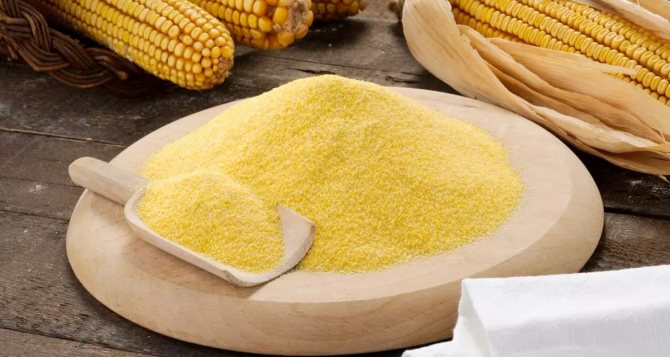
Rice flour
This flour contains quite a lot of starch and little fiber. But despite this, it fits into the concept of a healthy diet, because rice flour is rich in vitamins B, E and PP and valuable microelements. And it's gluten-free! It rids the body of harmful substances, removes excess fluid and usually does not cause allergies. Although it is quite high in calories, it is recommended to add it to baked goods instead of wheat flour. It makes delicious cheesecakes, pancakes and pancakes.
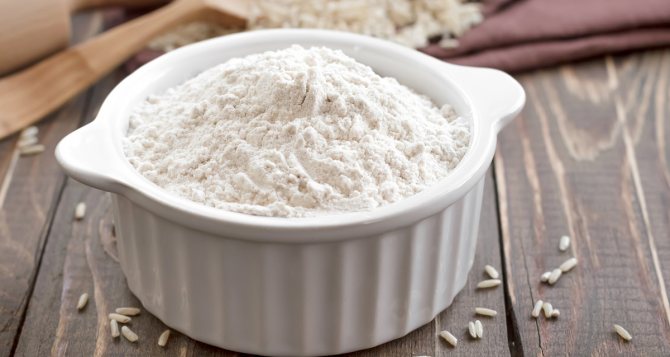
Rye flour
Typically this flour is used to make bread. Rye flour is low in calories and high in fiber. It is rich in vitamins E, K, A and group B. It contains a large amount of iron, manganese, magnesium and potassium. It also contains the beneficial amino acid lysine. Rye flour is an ideal option for a healthy lifestyle!
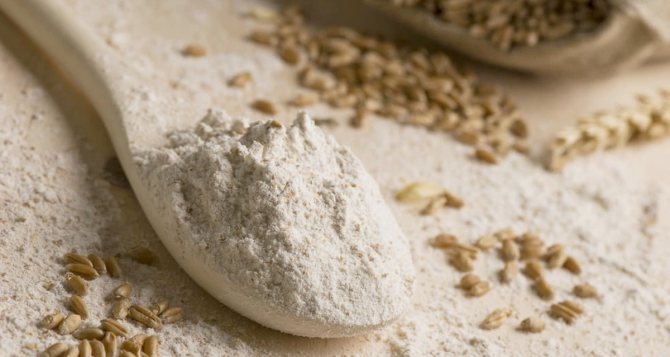
Oat flour
Contains a bunch of useful vitamins and microelements! It contains almost no starch and gluten. For athletes - the best choice. But there’s really a lot of fat, so you shouldn’t lean too heavily on this flour. You can use oatmeal to make your own famous oatmeal pancake for breakfast!
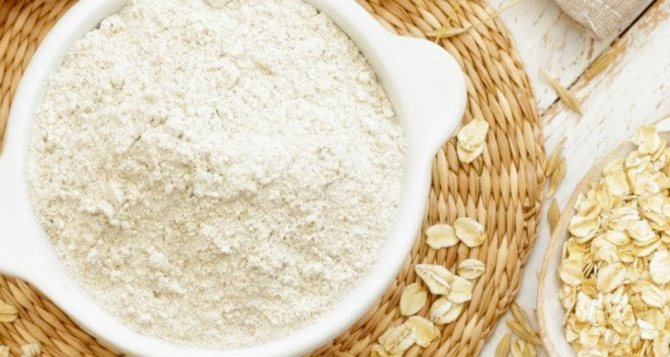
Read here what you can make from healthy flour!
Source




